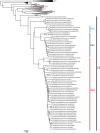Puumala Hantavirus Genotypes in Humans, France, 2012-2016
- PMID: 30561320
- PMCID: PMC6302603
- DOI: 10.3201/eid2501.180270
Puumala Hantavirus Genotypes in Humans, France, 2012-2016
Abstract
The analysis of the nucleoprotein gene of 77 Puumala hantavirus strains detected in human samples in France during 2012-2016 showed that all belonged to the Central European lineage. We observed 2 main clusters, geographically structured; one included strains with the Q64 signature and the other strains with the R64 signature.
Keywords: France; Puumala virus; genotype; hantavirus; humans; orthohantavirus; viruses; zoonoses.
Figures


References
-
- International Committee on Taxonomy of Viruses (ICTV). 2016.023a-cM Hantavirus approved proposal. 2017 March 19. [cited 2018 Feb 9]. https://talk.ictvonline.org/ICTV/proposals/2016.023a-cM.A.v2.Hantavirus_...
Publication types
MeSH terms
LinkOut - more resources
Full Text Sources
Medical
Molecular Biology Databases

